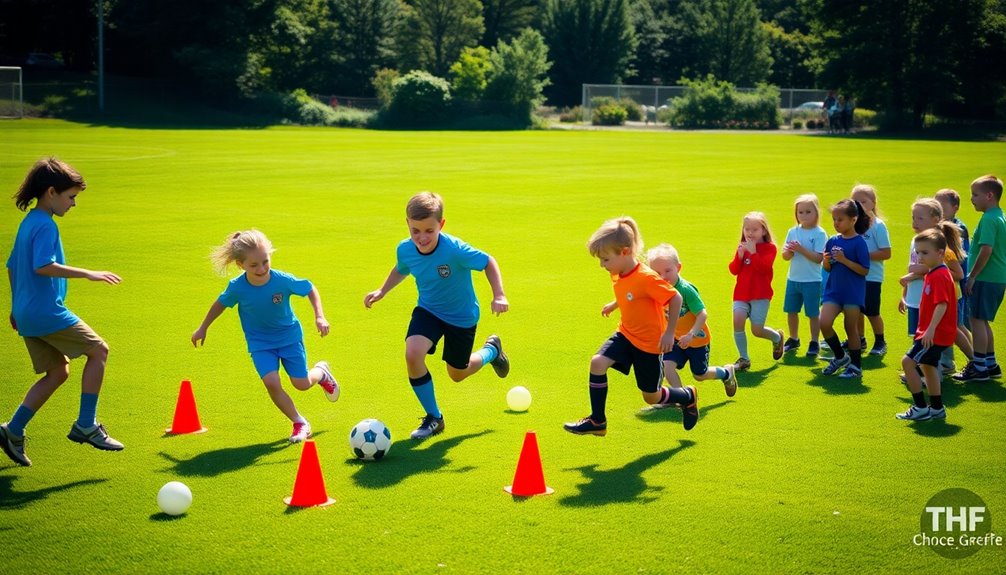
Skill-Building Soccer Drills for 8-Year-Olds
February 8, 2025Skill-building soccer drills for 8-year-olds focus on making practice enjoyable while enhancing essential skills like dribbling, passing, and teamwork. You can try fun activities like "Fill the Bucket" to improve ball control or "Sharks and Minnows" to develop quick decision-making. These drills engage young players, keeping their attention and fostering a love for the game. Incorporating small-sided games also promotes cooperation and builds confidence. Remember, creating a positive atmosphere is key! If you're enthusiastic to discover more entertaining drills and tips to boost their skills, you'll find some exciting options ahead.
Overview of Soccer Drills
Soccer drills for 8-year-olds are essential for developing fundamental skills while keeping the game enjoyable. At this age, young soccer players are ready to enhance their dribbling skills, passing, and teamwork through engaging activities. Regular practice of these drills contributes to consistent effort and skill refinement. Understanding the principles of pressure and cover can also help young players make better decisions during games.
Fun soccer drills like "Fill the Bucket" and "British Bulldog" focus on these core skills while ensuring that practice feels more like play. You can adapt these soccer drills for small spaces, which emphasizes close control and quick movements, vital for young players. Games such as "Sharks and Minnows" and "Ball Hog" not only promote ball control and agility but also encourage strategic thinking, allowing kids to experience game-like scenarios.
Incorporating competitive elements into youth soccer practice, like "Kick The Coach," helps improve shooting accuracy and power while fostering a spirit of friendly competition. Additionally, engaging in agility drills will further enhance their maneuverability and quickness on the field.
Remember, the key to successful drills is enjoyment. Engaging activities help sustain interest and motivation, ensuring your young players develop a lasting love for the game.
Benefits of Fun Drills
Fun drills are key to keeping 8-year-olds engaged and excited about soccer practice.
When you incorporate enjoyable activities, kids not only learn skills more effectively but also develop teamwork and cooperation. This positive environment fosters a love for the game that can last a lifetime. Additionally, endurance training methods can be integrated into fun drills to enhance the physical fitness of young players while they enjoy the game. Incorporating dynamic stretches into warm-up routines can further prepare them for physical activity and reduce the risk of injuries. These warm-up exercises are essential for injury prevention and muscle preparation before intense activities.
Enhances Player Engagement
How can coaches keep 8-year-olds engaged during practice? The key lies in incorporating fun soccer drills that spark their interest and enthusiasm.
Drills like "Sharks and Minnows" or "British Bulldog" introduce competitive elements that make practice enjoyable, boosting engagement among young players. When you create a lively atmosphere, players are more likely to participate actively, fostering social interactions and teamwork.
Fun drills also cater to the short attention spans typical of this age group, helping maintain focus and allowing for better retention of skills.
When practice feels like play, it encourages creativity and exploration, which are essential for building confidence on the field. This relaxed environment reduces performance pressure, making it easier for young players to experiment without fear of failure.
Promotes Skill Acquisition
Engaging players in enjoyable drills naturally leads to skill acquisition that sticks. Fun U8 soccer activities, like "Sharks and Minnows" and "Fill The Bucket," not only capture the attention of young players but also greatly enhance their dribbling, ball control, and decision-making skills.
When you incorporate competition into these drills, you create excitement that boosts motivation, making it easier for players to remember essential soccer skills like passing and shooting.
These engaging activities reduce performance pressure, allowing kids to explore their creativity and develop a love for the game, vital for long-term participation in soccer. With a focus on fun, youth soccer coaches can foster an environment where players feel comfortable trying new techniques and strategies.
Moreover, fun drills improve cardiovascular health and agility, as they require quick movements and strategic thinking under pressure. This combination of enjoyment and skill development not only enhances individual players but also helps build essential communication skills among teammates.
Fosters Teamwork and Cooperation
The benefits of incorporating fun drills into practice are clear: they foster teamwork and cooperation among young players. Drills like "Capture the Balls" and "Team Ball Tag" encourage players to work together, enhancing their ability to communicate and strategize as a team.
These engaging activities require players to cooperate, not just to succeed in the drills but also to build strong relationships with their teammates.
In games like "Sharks and Minnows," players must evade defenders while collectively trying to reach a goal. This promotes a sense of unity and trust, essential components of effective teamwork.
Additionally, team-oriented drills create a sense of belonging and camaraderie, which can lead to improved performance both on and off the field.
Regularly practicing fun drills strengthens players' willingness to cooperate, fostering better teamwork dynamics during competitive matches. As children learn to share and support one another, they develop important social skills that are significant for their overall growth.
Importance of Enjoyment
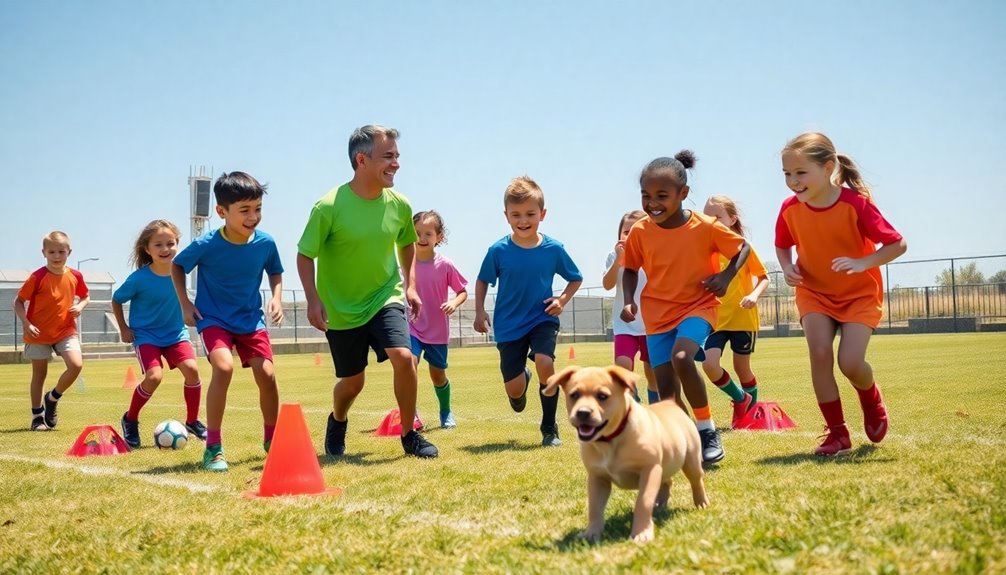
When kids enjoy what they're doing, they're more likely to stay engaged and motivated in soccer. By incorporating fun into your drills, you're not just teaching skills; you're fostering a love for the game that can last a lifetime. This love for the game often translates into a greater commitment to teamwork, enhancing their overall development as players. Engaging in enjoyable drills can also help them grasp essential skills that contribute to their performance on the field.
Creating a positive and enjoyable environment also helps them connect with teammates and build friendships, making the sport even more rewarding. Additionally, fostering teamwork and collaboration can significantly enhance their overall experience and performance on the field.
Engagement Through Fun
Creating a fun atmosphere in youth soccer is vital for keeping players motivated and enthusiastic to learn. When you incorporate fun into your soccer drills, you enhance engagement among young players, making them more likely to actively participate and enjoy the learning process.
With their short attention spans, kids thrive in environments filled with enjoyable activities that hold their interest and encourage skill development. By designing drills that emphasize enjoyment, you not only make practice more appealing but also foster social interaction and teamwork.
These elements are essential for young players as they help build camaraderie and develop important life skills. US Soccer guidelines highlight the importance of this fun environment, noting that it greatly contributes to skill retention and positive learning experiences.
Moreover, when practice feels less like a chore and more like an exciting game, you reduce pressure on your players. This supportive setting allows them to explore their creativity, making it easier to improve their abilities.
Fostering Love for Game
Fostering a love for the game starts with making soccer enjoyable for young players. When you create a fun and engaging practice environment, you tap into the primary motivator for children participating in sports. According to US Soccer guidelines, incorporating enjoyable experiences is crucial for maintaining children's interest in soccer.
Using games and competitions in your drills can help sustain your young players' attention and enthusiasm, especially since their attention spans are shorter at this age. By focusing on fun, you not only enhance their skill retention but also promote social interaction and teamwork, which are essential aspects of the game.
A positive atmosphere encourages young players to develop resilience, teaching them to move past mistakes and concentrate on improvement rather than fearing failure. When they associate practice with fun, they're more likely to return and continue honing their skills.
Ultimately, by prioritizing enjoyment in your coaching approach, you're laying the foundation for a lasting love for soccer. As your players grow, they'll carry this passion for the game with them, fostering a lifelong appreciation for soccer and sports in general.
Adapting Drills for Spaces
How can you make the most of limited training spaces for 8-year-olds? Adapting your drills to fit small areas can greatly enhance their skills. Focus on dribbling drills that encourage players to navigate tight spaces, emphasizing control and quick movements.
For instance, set up cone dribbling or gates dribbling in a small space to sharpen agility and spatial awareness. Incorporating elements of pain shuttles drill can further improve their cardiovascular endurance and speed in these confined settings. Additionally, practicing ball control drills will help players maintain possession even under pressure. By utilizing these smaller training drills, you'll help players master essential skills before moving to larger practice games. This approach builds a solid foundation, ensuring they're well-prepared for more complex situations on the field. Flexibility is key—modify your activities based on the available space and the specific skill levels of your players. Incorporating fun elements and variations in your small space drills keeps players engaged while focusing on vital skills like dribbling, passing, and shooting. Additionally, incorporating regular practice can further solidify their development and adaptability on the field.
Evaluating Player Progress
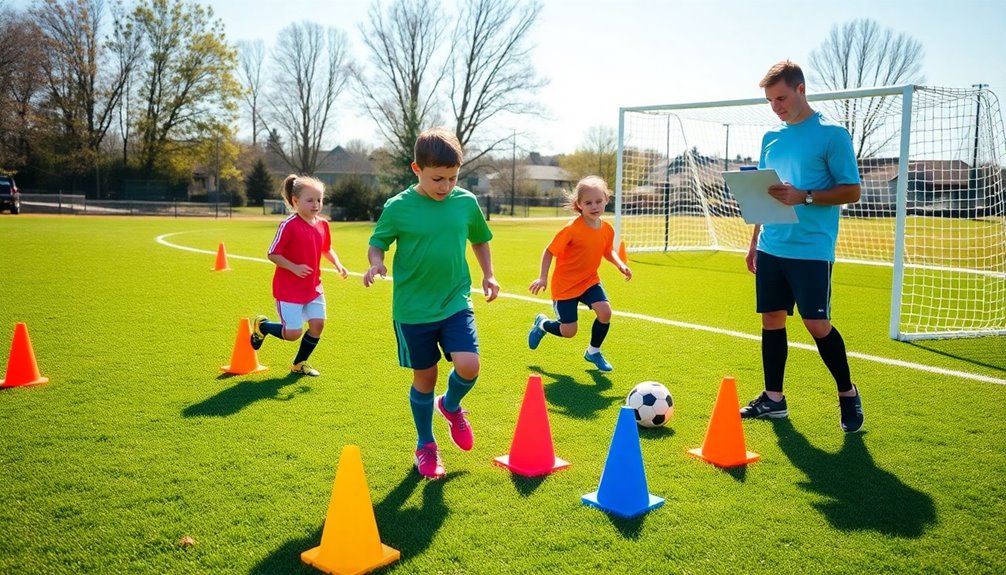
To effectively evaluate player progress, you need to observe how each child performs during drills. This observation helps you identify individual strengths and areas that need improvement. Incorporating teamwork enhancement exercises can also provide insights into how well players communicate and cooperate with one another during practice. Furthermore, understanding the roles and responsibilities of different positions can aid in assessing players' development in specific skill sets related to their designated roles on the field. Additionally, regularly practicing basic soccer moves can significantly enhance a child's fundamental skills and overall game performance.
Observing Drill Performance
Evaluating player progress during drills is essential for effective coaching, as it helps you pinpoint each child's strengths and weaknesses. By observing player performance closely, you can identify specific areas where each player excels or needs improvement. Tracking metrics like the number of successful passes or dribbles completed during a drill allows you to assess skill progression over time.
Regular evaluations during practice sessions provide continuous feedback, which helps players understand their areas for improvement and boosts their confidence. You can also use informal assessments during small-sided games to gauge decision-making skills and teamwork, critical components of player development.
Utilizing drills as evaluation tools not only aids in skill assessment but also encourages players to reflect on their performance. This reflection can lead to the establishment of personalized development plans tailored to individual needs.
When players set personal goals based on your observations, they become more motivated to improve. By consistently observing their performance, you guarantee that each child receives the guidance they need to grow as a soccer player, ultimately fostering a more effective learning environment.
Individual Development Plans
Building on the insights gained from observing drill performance, Individual Development Plans (IDPs) offer a structured approach to enhance each player's skills. With IDPs, you can tailor training sessions based on your observations, creating personalized skill enhancement strategies that truly meet each player's needs.
Regular evaluations during drills help identify specific areas of improvement, ensuring you focus on developing their unique abilities. Incorporating feedback from these plans is essential for fostering player growth. By setting achievable goals and tracking progress over time, you'll not only boost motivation but also build self-confidence in your players.
This method allows you to assess not just technical skills, but also decision-making, teamwork, and overall game understanding, promoting well-rounded player development. Additionally, evaluating player performance through IDPs keeps practice sessions engaging.
You can adjust your training to meet the evolving needs and capabilities of each athlete, ensuring that they remain challenged and invested in their development. By implementing IDPs, you create a dynamic training environment where players can thrive, making soccer even more enjoyable for everyone involved.
Enhancing Decision-Making Skills
Enhancing decision-making skills is vital for young soccer players, as it helps them navigate the complexities of the game with confidence. Incorporating engaging dribbling drills into your practice plans can greatly improve these skills.
For example, the Sharks and Minnows drill simulates real-game scenarios, pushing players to make quick decisions while dribbling past defenders and protecting the ball.
Another effective drill is the 1,2,3 Challenge. Here, players dribble while evaluating their options for scoring or maintaining possession against opponents, promoting strategic thinking.
Small-sided games also play an important role, as they provide more individual touches on the ball, allowing players to practice and refine their decision-making skills in varied situations.
Lastly, drills like Ball Hog encourage players to assess their surroundings swiftly, making rapid choices on whether to shield or reclaim the ball.
Regular practice in these decision-focused drills fosters a deeper understanding of spacing, timing, and teamwork, all of which are vital for effective play during matches.
Make these drills a staple in your soccer training to enhance your young players' decision-making skills and overall game performance.
Recommended Training Equipment
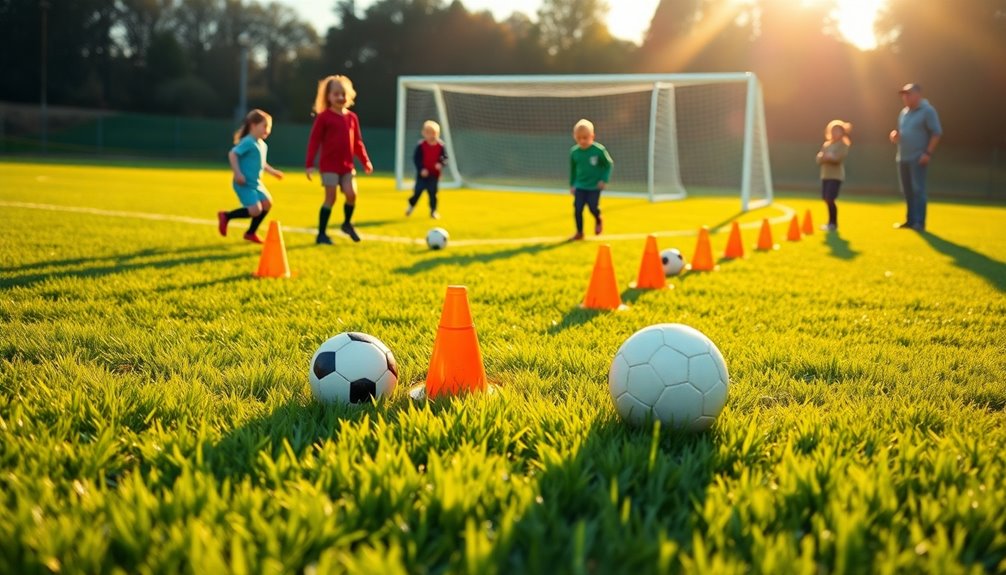
To maximize the benefits of your training sessions focused on decision-making skills, having the right equipment is key. Start with a versatile 3-in-1 soccer goal for juniors. This allows you to practice small-sided games, shooting techniques, and goalkeeping drills, enhancing overall training efficiency.
Next, incorporate rebounders into your setup. They're vital for facilitating continuous ball movement, which minimizes downtime and lets players practice passing, shooting, and receiving without constant ball retrieval.
You'll also want a good supply of cones. These are significant for setting up various drills, helping improve agility, ball control, and spatial awareness.
Don't forget about training vests or pinnies. They help differentiate teams during drills and add a fun element to practices while promoting organization and teamwork.
Finally, consider portable pop-up goals. They're perfect for small spaces and enable quick setups for shooting drills and small-sided games, encouraging active participation and skill development.
With this equipment, you'll create an engaging training environment that fosters decision-making and enhances your players' skills effectively.
Skill-Building Drills
Skill-building drills for 8-year-olds are essential for mastering the core techniques of soccer, like dribbling, passing, shooting, and teamwork.
One fun drill is "Fill the Bucket," where players race to dribble their balls into a central bucket. This drill sharpens their ball control and speed while adding a competitive edge.
Another great exercise is "Sharks and Minnows." In this game, players try to dribble through a designated safe zone while avoiding being tagged by a "shark." This not only enhances their dribbling skills but also keeps them engaged and motivated.
"2 vs. 1 to Goal" is an effective small-sided game that fosters decision-making in attacking scenarios. Here, players collaborate to create scoring opportunities against a defender, sharpening their tactical awareness.
Passing and Teamwork Drills
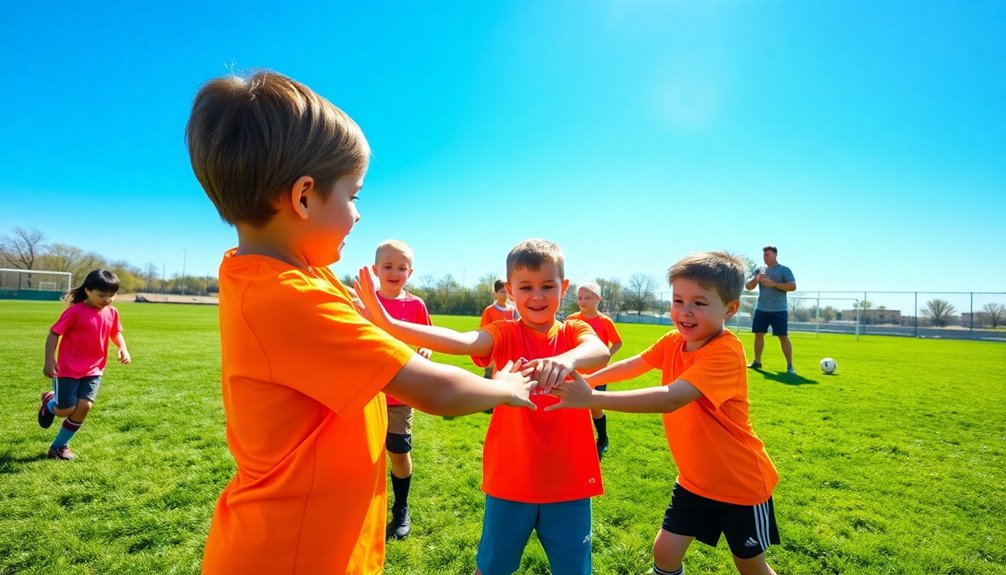
Passing and teamwork drills are essential for young soccer players as they lay the foundation for effective on-field collaboration. These drills not only enhance individual skills but also encourage players to work together seamlessly.
Here are three engaging drills you can incorporate:
- Pass and Move: Players pass the ball and immediately shift to a new position, emphasizing communication and spatial awareness.
- Triangle Passing: Three players form a triangle and pass the ball to one another, sharpening passing precision and timing.
- Two-Ball Passing: Three players keep two balls away from a defender, promoting quick thinking and teamwork under pressure.
In addition to these, you might want to try a possession game where teams complete a specific number of passes to score. This reinforces the importance of maintaining possession.
Gates passing is another fun drill; players aim to pass through pairs of cones to improve accuracy and find open spaces.
Shooting and Goalkeeping Drills
Shooting and goalkeeping drills are essential for developing confidence and competence on the field. By practicing various shooting techniques, you'll improve both your accuracy and power.
Start with Shooting Practice, where you can focus on different shots in game-like scenarios. The Finishing Off a Cross drill mimics real-game situations, helping you master timing and positioning to finish effectively.
Incorporate teamwork with the Four-Cone Shooting drill. Here, you'll pass to teammates before taking shots, enhancing your ability to shoot accurately under pressure.
For goalkeepers, the Two-Cone Goalie Drill sharpens your reflexes and decision-making. You'll practice saving rolling balls while sprinting to designated cones, simulating real match conditions.
Additionally, Catch and Release drills for goalkeepers will improve your reaction time and changeover skills. By catching shots and quickly distributing the ball, you'll learn to respond promptly during games.
These shooting and goalkeeper drills not only build individual skills but also foster a sense of teamwork, vital for effective play. Embrace these drills to elevate your game and become a more confident player on the field!
Competitive Games for Kids
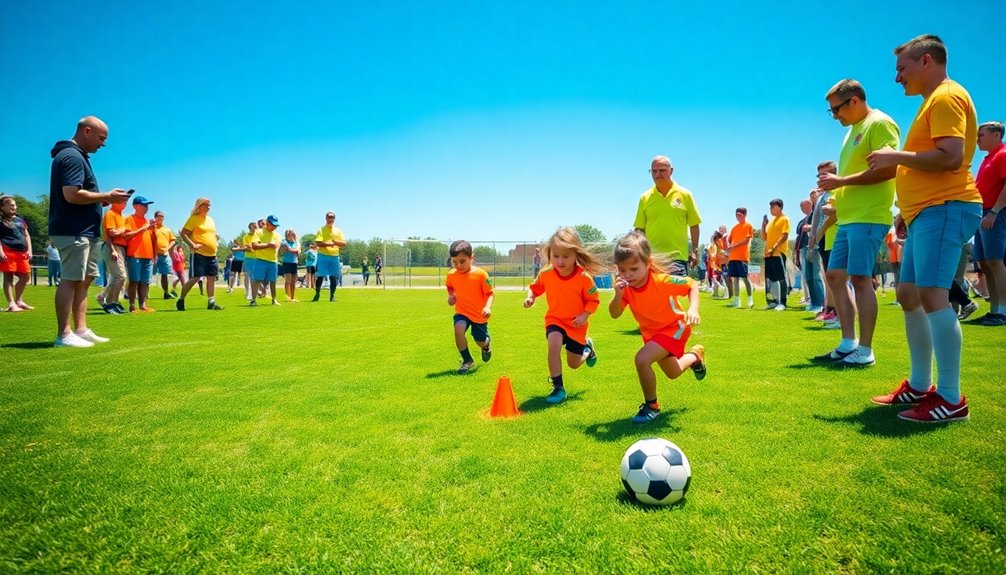
After honing your shooting and goalkeeping skills, it's time to shift the focus to competitive games that keep young players engaged and improve their overall game understanding. These activities not only promote fun but also reinforce essential soccer skills like dribbling and teamwork.
Here are some great options:
- Sharks and Minnows: This game encourages players to protect the ball while evading defenders, enhancing quick decision-making and dribbling skills.
- British Bulldog: In this game, players navigate a designated area while trying to avoid being tagged, boosting agility and dribbling under pressure.
- Capture the Balls: This game fosters teamwork and communication as players strategize to retrieve balls while overcoming obstacles.
Another effective drill is 2 vs. 1 to Goal, where players learn to work together in attacking scenarios, improving their decision-making skills.
Finally, Kick The Coach allows players to practice their shooting accuracy in a competitive setting, keeping them engaged while reinforcing crucial skills.
Incorporating these competitive games into your practice won't only enhance your players' abilities but also cultivate a love for the game.
Conclusion
Incorporating these skill-building drills into your training can transform your young players into confident soccer stars. Just imagine the thrill of watching them weave through defenders, executing perfect passes, and scoring goals with smiles on their faces. When you focus on fun and teamwork, you're not just teaching soccer skills; you're fostering a lifelong love for the game. So, grab those cones and balls, and let's turn practice into an adventure that your kids will cherish!


